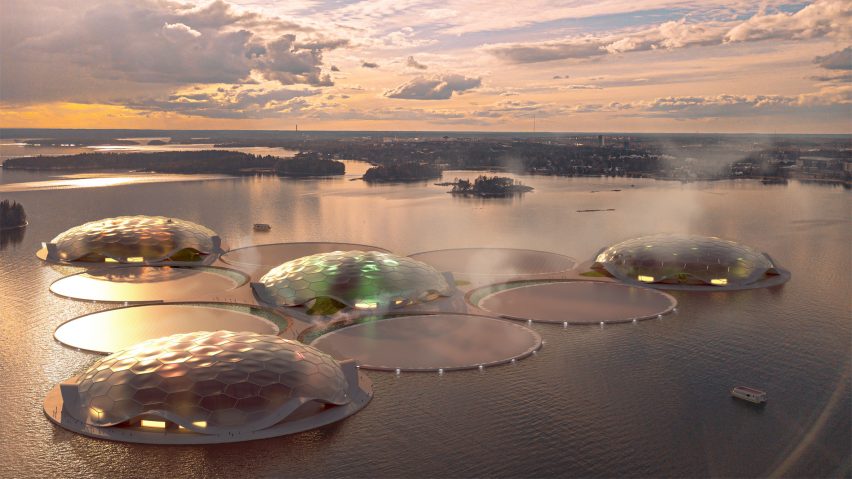
Carlo Ratti Associati proposes floating reservoirs to create carbon-free heating for Helsinki
Italian studio Carlo Ratti Associati is among four winners of the global Helsinki Energy Challenge, with a proposal to create island-like, floating seawater reservoirs that would store heat to help decarbonise the city's heating network.
The international Helsinki Energy Challenge was launched in 2020 to unearth sustainable alternatives for urban heating networks, using Helsinki as a testbed.
Officials in the Finnish capital intend to use the winning solutions to reduce the city's dependence on coal and biomass, in order to meet its target of carbon-neutrality by 2035.
Floating islands will store heat for winter
Carlo Ratti Associati's design, named Helsinki's Hot Heart, comprises 10 floating reservoirs that are filled with hot seawater, mimicking a small archipelago. The system would use seawater heat pumps to convert mainly carbon-free electrical energy from sources such as wind and solar power into heat.
The circular basins would then work together like a giant thermal battery, storing the heat that has been converted from renewable energy so that it is readily available for district heating in the winter.
Four of these reservoirs will also be covered by inflatable roof structures to create a series of enclosed recreational spaces.

These will be filled with plants from tropical ecosystems and lit by LED lights that mimic sunlight, offering a "unique public space" for locals and visitors throughout the year.
According to Carlo Ratti Associati, the project is hoped to be fully implemented in 2028 and would cover Helsinki's entire heating needs. It is being developed in collaboration with Squint/Opera, Ramboll, Transsolar, Danfoss/Leanhear, Schneider Electric, OP and Schlaich Bergermann Partner.
AI-driven energy system another winner
Other winning proposals include Smart Salt City, a new model for an energy system that uses artificial intelligence to monitor demand and supply forecasts.
Designed by SaltX Technology and Rebase Energy, it relies on renewable energy technologies for heat, but will also utilise thermochemical energy storage – thermal energy that is stored as chemical energy – for times when demand is not met.
A scheme that proposes the installation of heat pumps within the Baltic Sea to meet 50 per cent of Helsinki's heating demand was also a winning design, conceived by Storengy, Newheat, Engie, PlanEnergi, AEE Intec and Savosolar.
Named HIVE, it would also utilise solar thermal fields, thermal energy storages and district heating optimisation.

The fourth winning scheme, named Beyond Fossils, is "an energy transition management model". It proposes that Helsinki replaces using coal for heating by 2029 through clean heating auctions – a process where renewable energy developers bid against each other to supply energy.
It was put forward by the VTT, Hansel and the Finnish Environment Institute.
Helsinki to share solutions "around the world"
The winners of the Helsinki Energy Challenge were selected from 252 teams, ranging from tech start-ups to banks, engineers and architects, from 35 countries.
Carlo Ratti Associati will take a share of a prize fund worth one million euros, split between the four teams.
While helping Helsinki decarbonise, the organisers hope the competition will also encourage other cities to "take the energy revolution into their own hands" in order to achieve carbon-neutrality.
"Helsinki is not alone: to fight climate change, sustainable heating solutions are needed in cities all over the world – heating not just beyond coal, but also beyond burning biomass," organisers said.
"The City of Helsinki is committed to sharing the lessons learned and results gained in the competition so that also other cities around the world can use them in their climate work."
London is another city that is trying to find sustainable ways to support its district heating networks. In the Borough of Islington, waste heat is channelled from the Northern Line tube to the grid to warm offices, leisure centres and 1,350 homes.
The system was developed with engineering firm Ramboll to make London more self-sufficient in energy while cutting carbon emissions and reducing heating bills.
Visuals are by Carlo Ratti Associati.